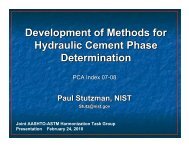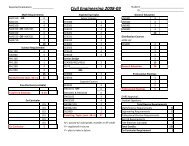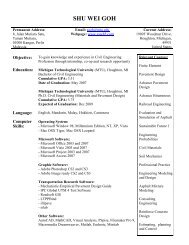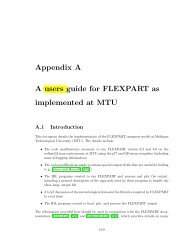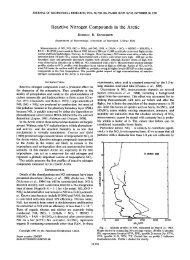Evaluation of Septic Tank and Subsurface Wetland for
Evaluation of Septic Tank and Subsurface Wetland for
Evaluation of Septic Tank and Subsurface Wetland for
You also want an ePaper? Increase the reach of your titles
YUMPU automatically turns print PDFs into web optimized ePapers that Google loves.
The water level in the middle <strong>of</strong> the wetl<strong>and</strong> was 19.5 inches. Assuming there was no<br />
overflow at the manhole, the water level in the manhole was 6.5 inches (0.165m) higher<br />
than in the middle <strong>of</strong> the wetl<strong>and</strong> bed. The width <strong>of</strong> the wetl<strong>and</strong> is 7.3 ft or 2.23 m.<br />
Using wetl<strong>and</strong> bottom as reference, the average depth <strong>of</strong> water between the manhole <strong>and</strong><br />
mid-wetl<strong>and</strong> point is 26 inches (0.660 m) minus 19.5 in (0.495 m) or 0.576 m. This data<br />
may be summarized as Q = 4.73 m 3 /d, dL = 7.24 m, dh = 0.165 m, W = 2.23 m, <strong>and</strong> Dw<br />
= 0.576 m. Applying Darcy’s Law equation K = Q dL / dh W Dw results in the hydraulic<br />
conductivity K = 172 m 3 /m 2 -d.<br />
This is a reasonable estimate <strong>for</strong> the average hydraulic conductivity <strong>of</strong> the first 50% <strong>of</strong> a<br />
wetl<strong>and</strong> bed that has been in service <strong>for</strong> two years. The field measured porosity <strong>of</strong> 37.7%<br />
corresponds to a hydraulic conductivity (K) in the range <strong>of</strong> 1,000 to 50,000 m 3 /m 2 -d<br />
(Reed, 2001). It is recommended that 1% <strong>of</strong> the clean conductivity be used <strong>for</strong> the initial<br />
30% <strong>of</strong> the bed <strong>and</strong> the remaining 70% <strong>of</strong> the bed is assumed to have a K <strong>of</strong> 10% <strong>of</strong> the<br />
clean K value (USEPA, 2000). If it is assumed that a clean K equals 10,000 m/d, then the<br />
first 30% <strong>of</strong> the bed would have a K <strong>of</strong> 100 m/d <strong>and</strong> the remainder <strong>of</strong> the bed K would<br />
have a K <strong>of</strong> 3,000 m/d.<br />
Since wetl<strong>and</strong> had an unmeasured quantity <strong>of</strong> effluent every week except <strong>for</strong> two weeks<br />
when the water supply was unavailable <strong>and</strong> the outflow was zero, the ET rate was based<br />
on data from these two weeks. During the water outage, buckets were used to supply a<br />
minimal amount <strong>of</strong> water <strong>for</strong> flushing so precipitation was the major source <strong>of</strong> water<br />
entering the system. ET based upon these two weeks was an estimated 0.24 USgal/ft2-d<br />
or10 mm/day. Under normal operating conditions the water level is high in this wetl<strong>and</strong><br />
so the water reaches the plant roots. During the two weeks when the water supply was<br />
<strong>of</strong>f, the water input was so low that the water level dropped below the root zone which<br />
may have caused a lower than normal ET rate.<br />
36



